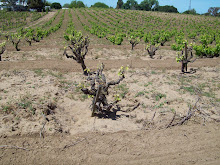
Another hellish week here at the ranch, though this one not so much feline-related (though the vet bill totals seem to take on extra zeroes daily). No, this time it’s been work-related stress on Kathy that, combined with a recent cold snap in our area, prompted her to send me an urgent e-mail:
“Please, can we do a Port run to Livermore on Saturday?”
I’ve posted about Livermore previously, and how this pioneering wine region due south of Brentwood and first planted to wine grapes circa 1840, has become our go-to AVA for Port-style wines. We’re always amazed at how many of the area’s 40-some wineries make fortified juice; it meant that Kath and I could indeed make a “Gumball Rally”-like dash down south specifically in search of Port-like treasure.
Of course, the term “Port” is proprietary, like the term “Champagne,” but slapping “Port’ on a label, even if it isn’t from Portugal, still seems like the best way to describe what to expect from what’s in the bottle. In Livermore the other day, we tasted Port-style wines made from Petite Sirah, from Zinfandel, even, at one winery, a selection comprising 100% Sangiovese.
More than one Livermore winery has committed to make a Port using only grape varieties that would go into a true Portuguese version, such as the varietal clones from the Tinta and Touriga families (weren’t they two of Columbus’ ships?). We visited Bent Creek Winery, whose 2007 Vintage version is a blend of five traditional Old World varieties. Not much of these true Port grapes is grown locally; many of the “true” Livermore Ports, Bent Creek’s included, are made with fruit sourced from Amador County to the northeast. But it’s still pretty surprising to learn that there’s any acreage of these relatively obscure Portuguese varieties in Cali at all.
In addition to dozens of boutique producers in the valley, Livermore is home to a couple of the “big boys” such as Concannon, producing wine since 1883, and Wente, whose current winemaker is the fifth generation of the Wente fam. We stopped in for an elegant lunch at the well-appointed restaurant at Wente Vineyards before walking over to their tasting room to continue “Port Quest 2011” with a lip-smacking Petite Sirah version.
With our haul of liquid rubies running to more than a half-dozen half-bottles, we made one final stop on our Port run. The tasting room was packed, and though our knowledgeable host/pourer was very professional and polite to Kath and me, he did give a quick, withering verbal beat-down to the dude on our right. Apparently, dude wanted more information from the label of a bottle directly in front of him on the counter, so he picked up the bottle to read, something I’ve done dozens of times. Our host leaned over to remark to him,”Do not touch the bottle. If you want information, I’ll give it to you.”
Thereby earning a Seinfeldian nickname from Kathy: “The Port Nazi.”



